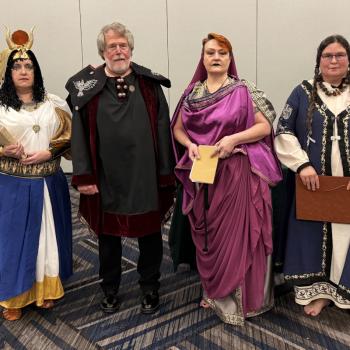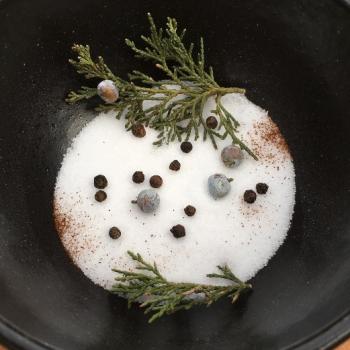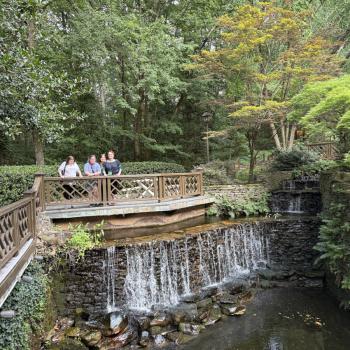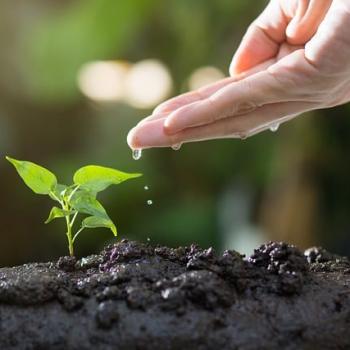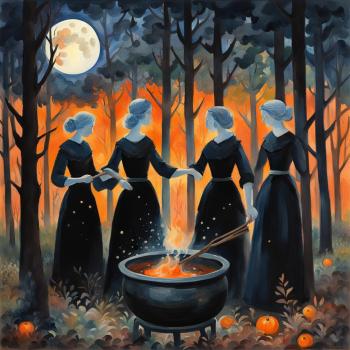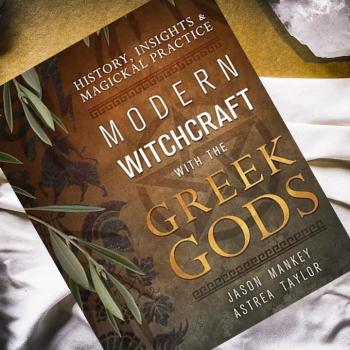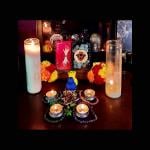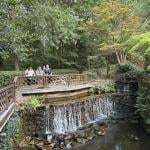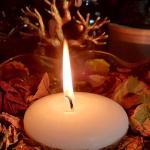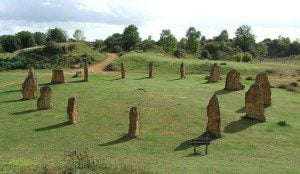
For March 2014, Patheos Pagan writers (and anyone else who wished to participate!) were invited to respond to the following prompt, developed by myself and Rhyd Wildermuth:
As Pagans, what do we hope to build?
Much of the current dialogue in the Pagan blogosphere is about carving out ways to explain and justify our personal experiences and beliefs in relation to other traditions, but without a clear vision of the place our own traditions and experiences might have in an ideal world. Will the Pagan movement become one tradition-heavy set of religions with several “fringes”? Will it split apart into competing factions? Or will we find a way to unite using some shared cultural language? What institutions will we build, or will we build institutions at all? What rights or recognition will we have in the larger society?
What does your Paganism look like in 50 years?
Writers responded passionately and articulately! Here are the entries so far.
Yvonne Aburrow, “If You Build It, They Will Come” and “What Happens When the Oil Runs Out?”
I would like to see Pagan weddings become legally recognised in England and Wales. I would like to be able to practice Pagan rituals in public without fear of harassment. I would like to see public bodies acknowledging Pagan holidays in listings of holidays both secular and religious…. I would like to see a Pagan student society in every UK university, and a Pagan temple accessible to every Pagan who wants it. I would like to see Pagan traditions covered in education about religion (not indoctrinating children into it, just teaching them the facts about it). I would like Pagan traditions to be full participants in interfaith councils and bodies….
So what can Pagans and other ecologically-minded people be doing to prepare for the eventual crash, or shift? We can reduce our own dependence on fossil fuels; campaign for investment in sustainable energy sources; campaign for environmental and social justice. But in addition to these, we can do magic (the art of changing consciousness in accordance with Will) to heal and protect the Earth and other living beings, and we can learn skills such as building roundhouses and coracles and boats, raising livestock, weaving, growing our own food, and so on. We can get involved with the transition towns movement and other sustainability initiatives, support organic farming, and check our own ecological footprint. We can build strong communities – not only of Pagans, but including others of good will.
John Beckett, “The Pagan World in 2064”
Temples and shrines will spring up, but they’ll be built as houses of the Gods, not as churches or community centers. They’ll be smaller than churches, less costly, and they may even be portable. Priesthoods will arise around the temples – most likely, the priesthoods will come first and then the temples will follow. Each priesthood will have its own requirements for entry and training, and priests will be expected to support themselves with full-time or part-time employment.
Julian Betkowski, “Shores, Oceans, and Orientations”
I would love for us to be able to think of ourselves as simply Pagan. I would love for us not to move past our differences, but to revel in them, and for our differences to be the things that make Paganism really special, really worthwhile. I think we can achieve this if we think of Paganism not as the place where we live, but as the journey we are taking, each of us together with the rest. If we can conceive of Paganism as an orientation, then I believe that we will soon come to find our differences to be intoxicating rather than alienating.
Nimue Brown, “What Do We Hope to Build?”
At the moment, the old gods are abstract for most of us. We do not look to the rain and sun with acute awareness that we might starve if the weather goes wrong. We do not come to Samhain and actually have to decide which of our animals to kill. We do not regularly bury our children. There is every probability that climate change will deliver us a much harsher, more demanding, and more likely to kill us way of life, something closer to ancestral experience. How will we relate to the gods of nature when they no longer seem like archetypes, viewed from the comfort and safety of a snug urban living room? How will we feel about the gods of the hunt and harvest when we have to deal personally with the realities of these things? What new gods will we find in the changing world of the future?
Cat Chapin-Bishop, “Sacred Fire”
We do not need to define our experiences of the holy in the same way. We do not need to blend together our theologies, vocabulary, or myths. But I think we are weakened forever if we allow our differences to distract us from what we know we hold in common: that we live our lives open to the possibility that on this day, we will encounter personally some source of that sacred fire. We walk through the world ready to be blessed.
Gus diZerega, “Looking to the Future: Pagan Religions in 50 Years”
Gatherings like Pantheacon will soon be unable to incorporate the full diversity of Pagan paths. In fact, if Pagan religions such as Santeria, Voudon, and Native American traditions sought representation in anything like their true diversity and numbers we would already be there. We are becoming too big as well as too diverse to enable every tradition or practice representation. We should be happy about this. It is evidence of our success.
Alyxander Folmer, “Pagans: IN SPAAACE!!!”
The Kibbutz is an Israeli concept that started in the early 1900′s. These are small, intentional, religious communities centered around a communal resource, like an urban farm. People in these communities are usually skilled artisans and farmers, who work to make self sufficient communities of like minded individuals. Given the environment that the Pagans of 2064 will be working with, I predict that those of us who want to build Pagan institutions will develop a type of “grove culture,” small communities or apartment complexes that support urban gardens and artisan crafts. Some of these may be tradition-specific, others might be more eclectic, but those will likely be the common elements between “groves”. These are two popular trends within our current community which could become valuable commodities within the next 50 years, and these groves could allow for both community and financial security. Hearth, Home, and Temple all wrapped up in small, self sustaining communities.
John Halstead, “‘A Mighty Host Respond’: Pagan Unity through Diversity”
Most interfaith and intrafaith discussions about community might be described as a search for the “holy One”. But in response to our call for Oneness, the world answers with a “mighty host”; it answers with the “ten thousand things”. I think the wider Pagan community might take a page from the polytheists and consider seeking unity in diversity, or better yet, unity through diversity. This is like what Jason Pitzl-Waters described as “solidarity, not unity”, but even more than that. It is a kind of unity, not in spite of our differences, but because of our differences. It is about seeing diversity, not as an obstacle, but as a strength, as a resource. It is about seeing our difference paradoxically as the real defining characteristic of Pagan community. This radically different kind of community is, I think, one of the promises of Paganism.
David Dashifen Kees, “The Pagan Collective”
I recommend that we work in the coming decades to build a federation of Pagans, something that I’ve begun to think of as a the Pagan collective if only to avoid the possibility of trademark infringement…. The journey toward the Pagan collective might not be at least as, if not more, important than the end goal of constructing such an organization. By working individually toward the goal of working together collectively, I suspect that we would all individually deepen and strengthen our religious communities.
Christine Kraemer, “The Future of Contemporary Paganism: Holding Paradox” and “What Pagans Can Learn from Pioneer Mormons”
Pagans frequently fear institutionalization because we do not want our religions to compromise their values. The movement, however, has grown too large; institutions will inevitably form in response to needs. In order for those institutions to reflect non-mainstream values, however, they must be structured in non-mainstream ways. Pagans will not thrive in the structure of traditional churches; we must build something new. The struggle to creatively embed paradoxical values—individuality and community, professionalism and egalitarianism, intimacy and inclusivity—into institutions is the primary Pagan challenge for the new century….
Although the internet does much to make the gathering of like-minded people possible, it alone cannot substitute for participation in the daily rhythms of other Pagans’ lives. That is something Mormons know that we Pagans have not fully grasped: sustainable community is better nourished by physical proximity and stable business and personal relationships than by shared beliefs.
P. Sufenas Virius Lupus, “The Ekklesía Antínoou in Fifty Years”
When the United States collapsed, and the various regions fragmented into their current status, there were some very strained and difficult days, but it ended up only being days, thankfully, as regional governments emerged quickly and often with little change from the previous state governments. It wasn’t ideal, by any means, but it was much smoother than many had feared. However, for three weeks, our Temple compound was a small place of sanctuary for people from the surrounding area, of many different religions. Everyone was accommodated, fed, and sheltered as long as they needed (and some of them ended up sticking around and becoming a part of our community, even though they brought their religions with them).
Jason Mankey, “Pagan Pipe Dreams (What Do We Hope to Build?)”
Does PBN work? I’m all about a Pagan Broadcasting Network. Sounds kind of silly, doesn’t it, but have you seen how many networks are run strictly by Evangelical churches? If you’ve got cable or satellite visit those nether-regions your TV remote rarely travels to and count them all up. They are numerous, and they mostly stink (though I will cop to watching some of them late at night as a weird sort of amusement). Maybe we should have our own channel!
Sterling, “My Wishlist for the Pagan Community”
There are Christian charities that build homes for the poor and Jewish charities that feed the hungry. Churches, synagogues and temples of all sorts organize community service projects that their members may take part in throughout the year. Our covens and groves should do the same. We should be involved in work that increases the resilience of our towns and cities. Just as there are Catholic Hospitals and Evangelical medical clinics, I would like to see the Pagan community build health centers of our own. (Perhaps just like Catholic hospitals refuse to do elective abortions, we could refuse to use unnecessary pharmaceuticals and focus instead on research-backed plant medicines whenever possible.)
Sam Webster, “Pagan Institutions: The Coin Is for All”
The Coin is also a way to crystalize power and energy in a very material way. The Coin can be used move that energy through time (it can be saved and used later) and through space (it can be sent and spent elsewhere). It can aggregate the power of many into a single focus. Also, the laws around this are very well developed and we can use them for our benefit. In creating things like corporate governance (internal structure) and contracts (external relationships), we get to form and formalize the rules we wish to operate by within very capacious structures provided by the law. The courts uphold these agreements with vigor.
Talking is not enough for me. I have to build.
Rhyd Wildermuth, “What We Built from Ruins” (Part One) (Part Two) (Part Three) (Part Four)
“But that was also a good time, despite that sadness. That’s when the gods came back.”
An auburn-haired woman–hair streaked with fiery red, her eyes burning with recognizable light of Lokean chaos– interrupted him. “But they were always there!”
He sighed, but smiled. Something in her ferocity reminded him of all those old arguments, mostly on those pale screens. They’d called it “the web,” he remembered, and he always shuddered when he thought on how much it’d been just like struggling against sticky spider threads in hopes of becoming free.
“Yes. I know. They’ve always been here. But not like they are now. They were in the in-between, out of our sight. Pushed out by our stubbornness and belief in our own cleverness. And back then we used to fight about who they were and how to find them and what they wanted or if they even existed at all.”
From elsewhere on the web:
Dave Christy, “What Do We Hope to Build?”
When I think about the Paganism of the future, I think about the role Paganism must play in making sure future generations thrive. I believe it is time for an earth-based liberation theology/satyagraha. The need for engagement seems most clear to me when I reflect on the challenges above and look to the Goddess I know best, the living-breathing Earth.
We live within the body of the Goddess.
We participate in her wellbeing.But if this is true, then it also true (on some level) that the Sacred is polluted and the Goddess is sick. The Earth communicating in the form of extreme weather–the Goddess is asking for help. We need new theologies and praxis to address these issues.
To do this we need to embrace our prophetic gifts. In particular there are three prophetic skills I believe we need to hone: speaking truth to power, listening to the voice of tomorrow (future generations), and reshaping symbols to meet those needs.
Bart Everson, “The Cult of Gaia in 2064”
These new groups dedicated to the celebration of Gaia will represent a confluence of contemporary Pagans (especially Naturalistic and Eco-Pagans), New Age practitioners, Goddess worshipers, Deep Ecologists, radical environmentalists, indigenous cultures, pantheists, religious naturalists, atheists, Buddhists and many others. They will not always use the name Gaia. Some will refer to the Great Mother, or Mother Nature, or Mother Earth, or simply the Earth, or some other name. Some will envision an anthropomorphized goddess, while others will seek to embrace the Earth just as she is, in leaf and rock and wave, without such imagery. Yet these groups will share a common understanding and a common experience of the Earth as a sacred system in which humans participate.
Brandy Williams, “A Pagan Future”
In a world in which resources are depleted unsustainably and wealth is increasingly distributed unequally, in which human impact has disturbed the climate and destroys the web of life, what does it mean to be Pagan? …The most critical thing we can do is to articulate our values and live by them. As a Pagan I see the divine in the world around me; it is sacred, and it is alive. The Renaissance struggle between the Church and natural philosophers which birthed mechanical philosophy lies at the root of our devaluation of matter and our inability to recognize that when we “use” it we kill it.
Gandalfina Ixtliyollotl Face-Heart
What does my paganism look like in 50 years?… Resisting the desire and push to mainstream and assimilate. Not only honoring our own paths, but honoring those under the pagan umbrella that confuse or throw us off, and uncompromisingly demanding that the rest of our overculture respect and honor them as well. WITHOUT CHANGE. Taking a special stance for the outsiders, the freaks, the mystics, the hermits, the wise crazy ones, the witches (see what I did there?) that they — we — are holy and important and must be accepted as full members of society (or as much so as they wish/need for their work) as they are.
Tommy Elf, “Building Toward the Idea of a Pagan Community Future”
I am proud of the way my local Pagan community stepped forward to donate canned goods and blood during last year’s Pagan Pride Day. But more intriguing to me is the idea of a collegiate scholarship fund for a student looking to head to college. For me, the degree would be immaterial to the point – instead, I look at the fund as a monetary manner to invest in the future of our Community.





